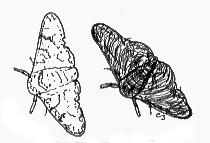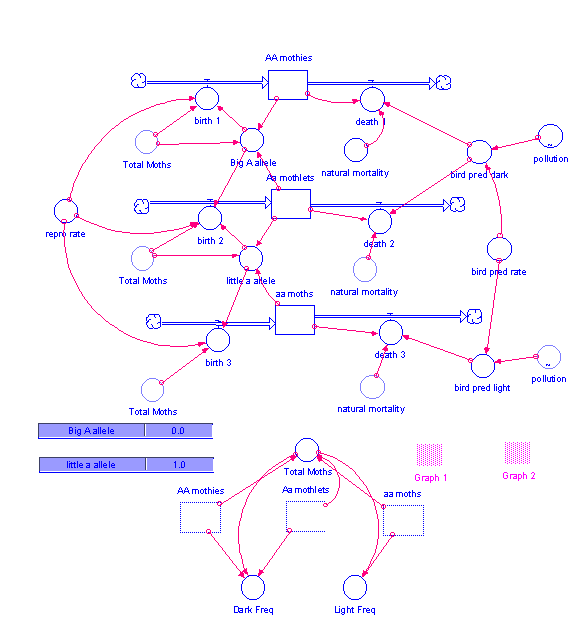Objective The purpose of this lab exercise is to model the effects of natural selection on the appearance and genetic make-up of a natural population (the peppered moth). We will construct a STELLA model for this population that incorporates the basic principles of population genetics. Before we begin, we will need to define some important genetics terminology: • Alternative forms of a gene are
called alleles.
Introduction The case of the peppered moth (Biston betularia) is a classic example of evolution through directional selection (selection favoring extreme phenotypes). Prior to the industrial revolution in England (pre-1740), the peppered moth was found almost entirely in its light form (light body colored with black spots). The moths would spend daylight hours on trees covered by a light colored lichen, their light colors giving them almost perfect camouflage against predatory birds. There were a few dark individuals in the population, but their occurrence was very rare. Scientists have determined that body color in the peppered moth is controlled by a single gene. The allele (version of the gene) for dark body color is dominant, which means that a moth possessing at least one such allele will have a dark body. (Each individual will have two copies of the gene–one from each of its parents.) To have a light body, the moth has to have both alleles for light body color. Dark moths were at a distinct disadvantage, however, due to their increased vulnerability to bird predation. Thus the frequency of the dark allele was very low (about .001%), maintained primarily by spontaneous mutations from light to dark alleles. By 1819, the proportion of dark moths in the population had increased significantly. Researchers found that the light-colored lichens covering the trees were being killed by sulfur dioxide emissions from the new coal burning mills and factories built during the industrial revolution. Without the light background of the trees, the light moths were more visible to vision-oriented predators (birds). They were losing their selective advantage to the dark moths, which, against the trees’ dark bark background, were less visible to birds. In 1848, the dark moths comprised 1% of the population and by 1959 they represented ~90% of the population. So, in 100 years the frequency of dark moths increased by 1000 fold! In this exercise, we will construct
a model simulating the effects of differential predation pressures on a
hypothetical peppered moth population. To do this, we will need to incorporate
the genetics of moth body color into a population dynamics model. We are
assuming that body color is the only trait that confers any significant
selective advantages on peppered moths.
Building the Model Use the diagram below as a guide to help you build the model. Keep in mind that you will have to use GHOSTS to create copies for duplicate variables. However, it is extremely important to make the "Total Moths" converter in the lower part of the model the original. Make sure the GHOST stocks are in the lower part of the model. Then, all the other ones can be ghosts copied off of it.
As with any system , we must first identify and define the stocks and flows of the system. Stocks
Note: Stella will not let you repeat variable names. Because Stella is not case sensitive, it doesn’t distinguish between the names "aa moths" and "Aa moths," so make sure to vary them (i.e. "moths" vs. "mothlets.") Flows
In these flows, the birth rate is calculated by multiplying the reproduction rate of the total population with the frequency of occurrence specific to that genotype. The allele frequencies are calculated as:
The term for total moths is calculated by using the GHOST to make copies of the 3 stocks and adding them together:
Also define variables that calculate the relative frequencies of dark moths (AA and Aa) and light moths (aa):
Now lets look at the death flows for our stocks:
The death flows incorporate a natural mortality rate as well as death resulting from predation by birds. Notice that the bird predation rates are different for dark and light moths. These two different predation rates are defined by:
Bird pred rate and pollution are both proportions between 0 and 1. Notice that with high rates of pollution, bird predation light is higher, while bird predation dark is highest when pollution is low. Below are the constants and rates that we have chosen for this model:
Set up two graphs for viewing results.
The first (graph 1) should display dark freq and light freq.
Set up the second graph (graph 2) to display numbers of
AA mothies,
Aa mothlets, and aa moths. The run specs for these runs
are starting at 0.0 to 200.0 with a DT = 1.0, and the time units set for
years. Next, set up numeric displays to observe the numeric changes in
allele frequencies (little a allele and big A allele.) Don’t
forget to select "retain ending value."
Investigating the System Since pollution is the true driver of the change in genotype frequency in the peppered moth population, it is the variable that we are most interested in modifying. Pollution is a proportional term, i.e. if it is zero there is no pollution and when it equals 1, pollution is at a maximum. Simulate the following three scenarios with your model. For each scenario, save graphs 1 (phenotypic response) and 2 (genotypic response) and copy and paste them into your word document. Make sure to label each graph with the value of the pollution variable (or write it in a caption under the graph).
Questions (due in Coursetools at the beginning of next lab period) Turn in the graphs showing phenotypic (graph 1) and genotypic (graph 2) responses in the moth population for each of the scenarios that you've tested.
|

